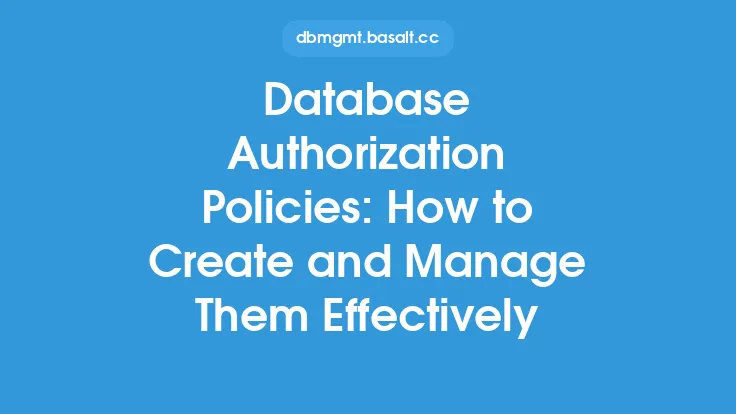As databases evolve, their schema often requires changes to accommodate new requirements, improve performance, or simplify maintenance. Database schema refactoring is the process of restructuring the database schema to make it more efficient, scalable, and maintainable. It involves modifying the existing schema to better support the application's needs, without changing the underlying data or disrupting the system's functionality. In this article, we will explore when and how to refactor a database schema, including the benefits, challenges, and best practices involved.
Introduction to Database Schema Refactoring
Database schema refactoring is a critical aspect of database maintenance, as it helps to ensure that the database remains aligned with the application's requirements and continues to perform optimally. Refactoring involves a range of activities, including renaming tables and columns, reorganizing data structures, and modifying relationships between tables. The goal of refactoring is to create a more efficient, scalable, and maintainable database schema that supports the application's needs and improves overall system performance.
When to Refactor a Database Schema
There are several scenarios in which database schema refactoring may be necessary. These include:
- Changing application requirements: When the application's requirements change, the database schema may need to be refactored to accommodate new data structures, relationships, or constraints.
- Performance issues: If the database is experiencing performance issues, such as slow query execution or high disk usage, refactoring the schema may help to improve performance by optimizing data storage, indexing, or query execution.
- Data inconsistencies: If data inconsistencies or errors are detected, refactoring the schema may be necessary to correct the issues and ensure data integrity.
- Merging or splitting databases: When databases are merged or split, refactoring the schema may be necessary to ensure that the resulting database is consistent, efficient, and scalable.
- Upgrading or migrating databases: When upgrading or migrating databases, refactoring the schema may be necessary to take advantage of new features, improve performance, or ensure compatibility with the new database management system.
How to Refactor a Database Schema
Refactoring a database schema involves several steps, including:
- Analyzing the existing schema: The first step in refactoring a database schema is to analyze the existing schema, including the data structures, relationships, and constraints.
- Identifying areas for improvement: Once the existing schema has been analyzed, the next step is to identify areas for improvement, such as performance bottlenecks, data inconsistencies, or inefficient data structures.
- Designing the new schema: With the areas for improvement identified, the next step is to design the new schema, taking into account the application's requirements, performance needs, and data integrity constraints.
- Creating a migration plan: Before refactoring the schema, a migration plan should be created to ensure that the changes are implemented smoothly and with minimal disruption to the system.
- Testing and validating the new schema: Once the new schema has been implemented, it should be thoroughly tested and validated to ensure that it meets the application's requirements and performs as expected.
Benefits of Database Schema Refactoring
Refactoring a database schema can have several benefits, including:
- Improved performance: Refactoring the schema can help to improve performance by optimizing data storage, indexing, and query execution.
- Increased scalability: A refactored schema can help to increase scalability by allowing the database to handle larger volumes of data and user traffic.
- Simplified maintenance: A refactored schema can help to simplify maintenance by reducing the complexity of the database and making it easier to manage and update.
- Improved data integrity: Refactoring the schema can help to improve data integrity by ensuring that data is consistent, accurate, and reliable.
- Better support for new features: A refactored schema can help to support new features and functionality, making it easier to add new capabilities to the application.
Challenges of Database Schema Refactoring
Refactoring a database schema can also present several challenges, including:
- Disruption to the system: Refactoring the schema can disrupt the system, causing downtime or errors, especially if not done carefully.
- Data loss or corruption: Refactoring the schema can result in data loss or corruption, especially if the changes are not thoroughly tested and validated.
- Compatibility issues: Refactoring the schema can cause compatibility issues with existing applications, tools, or systems that rely on the database.
- Performance issues: Refactoring the schema can cause performance issues, especially if the changes are not optimized for the database management system or hardware.
- Security risks: Refactoring the schema can introduce security risks, especially if the changes are not thoroughly tested and validated.
Best Practices for Database Schema Refactoring
To ensure that database schema refactoring is done successfully, several best practices should be followed, including:
- Thoroughly analyze the existing schema: Before refactoring the schema, it is essential to thoroughly analyze the existing schema, including the data structures, relationships, and constraints.
- Identify and prioritize areas for improvement: Once the existing schema has been analyzed, the next step is to identify and prioritize areas for improvement, such as performance bottlenecks, data inconsistencies, or inefficient data structures.
- Design the new schema carefully: The new schema should be designed carefully, taking into account the application's requirements, performance needs, and data integrity constraints.
- Create a migration plan: Before refactoring the schema, a migration plan should be created to ensure that the changes are implemented smoothly and with minimal disruption to the system.
- Test and validate the new schema: Once the new schema has been implemented, it should be thoroughly tested and validated to ensure that it meets the application's requirements and performs as expected.
- Monitor and optimize the new schema: After the new schema has been implemented, it should be monitored and optimized to ensure that it continues to perform optimally and meet the application's requirements.





